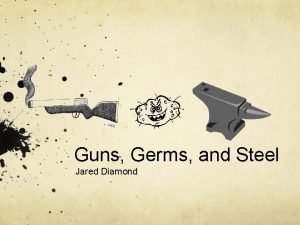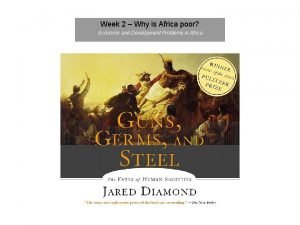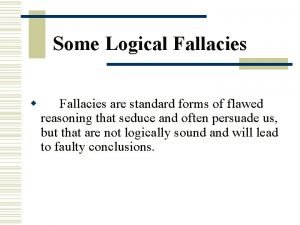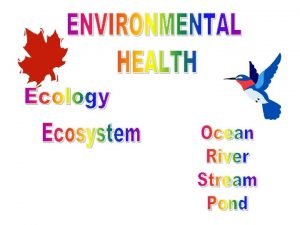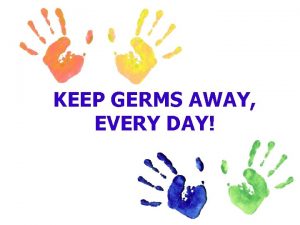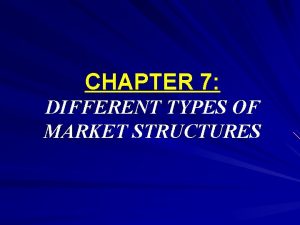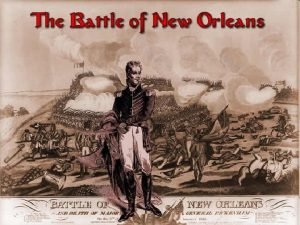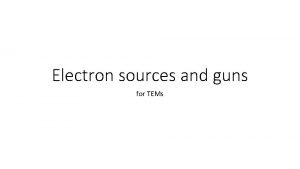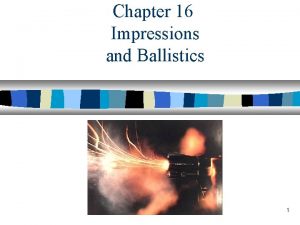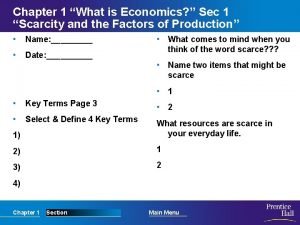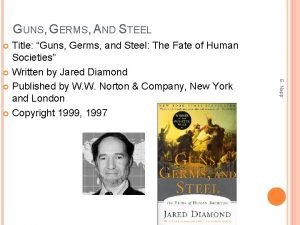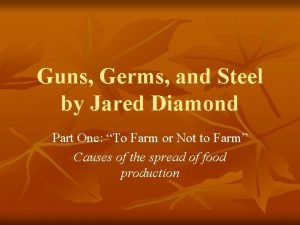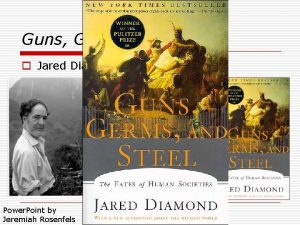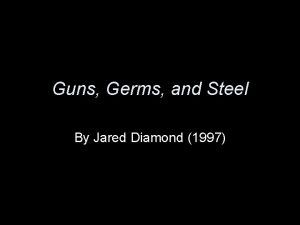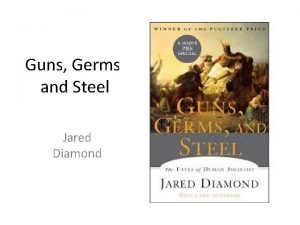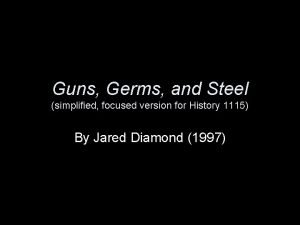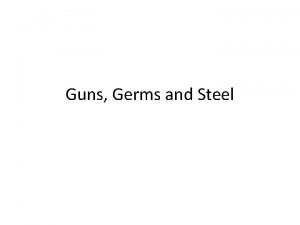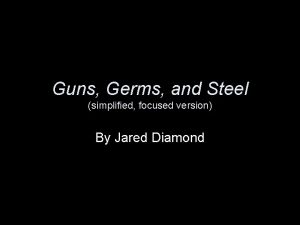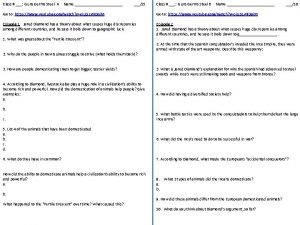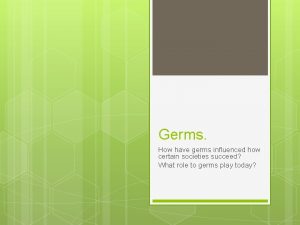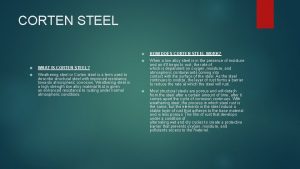Guns Germs and Steel Jared Diamond Yalis Question





























- Slides: 29

Guns, Germs, and Steel Jared Diamond

Yali’s Question… Why did some peoples develop more “cargo” than others? Why is A > B and not B >A?


Ch. 1: Up to the Starting Line

Ch. 2: The Great Leap Forward: 50, 000 years ago

Ch. 3: A Natural Experiment of History

Diverse geography, climate, resources, etc… Diverse peoples and adaptations.

Ch. 3 Collision at Cajamarca What allowed hundreds to defeat thousands?

Guns: harquebuses Combat advantage Germs: smallpox Power vacuum Steel: sailing technology Arriving in. Other Factors: Peru Writing/communication Religious Conquest

Ch. 4: Farmer Power Food production allows specialization and population growth.

Ch. 4: Farmer Power Animal domestication made everything easier. Provided milk, meat, manure for fertilizer, and plowing capabilities.

Ch. 5: History’s Haves and Have. Nots Cultural development was dependent on crops, animals, and their nutritional value. New Guinea The Fertile Crescent Taro Wheat Yams Flaxseed Sugar cane Barley No animals Sheep No grains Goat Less nutrition and resources More nutrition and resources Less development More development

Ch. 6: To Farm or Not to Farm Why did some hunter-gatherer communities while others have persisted into the modern day? Decline in big-game animals Domesticable plant availability Pressure from population growth

Ch. 7: How to Make an Almonds are poisonous in nature, how did they develop to be people-friendly?

Ch. 7: How to Make an Almond Consumption of mutant, edible almonds allowed more reproduction of the mutant gene. Fruits increase dependent dispersal by: Improving taste and Increasing size Did crops decide where humans settled? Wild vs. Supermarket

Ch. 8: Apples or Indians The people of the Fertile Crescent developed food production earlier because of their geography. Mediterranean climate Large grass seeds Early-domesticated animals Mediterranean humans Optimized food production

Ch. 9: Zebras, Unhappy Marriages, and the Anna Karenina Principle ≈ Domesticable animals are all Anna Karenina Principle: Happy alike; every undomesticable families are all alike; every animal is undomesticable in unhappy family is unhappy in its own way. Characteristic Necessity for Domestication Diet Omnivorous or herbivorous Growth Rate Decently fast (elephants = too slow) Breeding Able in captivity/under surveillance Disposition Compliant with captivity Danger Reaction Low panic levels Social Structure Acceptance of subordinate role

Ch. 10: Spacious Skies and Tilted Axes The Americas’ and Africa’s north-south axis contained many climates. Eurasia’s axis expresses much less latitudinal range, therefore less climate variety. High climate variety High species variety and disease variety.

Ch. 11: Lethal Gift of Livestock Farming = more exposure to animals = higher chance of disease Cattle Smallpox, tuberculosis, measles Creation of human epidemics 1. Animals occasionally infect humans 2. Short lived human to human diseases 3. Lasting human to human diseases 4. Epidemics exclusive to humans Large populations allow disease to spread faster More people become immune European diseases killed about 95% of the New World Population upon European arrival

Ch. 12: Blue Prints and Borrowed Letters Writing started with cuneiform in Sumerian southwest Asia. Other peoples copied this alphabet or diffused the idea. Developed in stratified societies, not needed in hunter gatherer societies.

Ch. 13: Necessity’s Mother Invention can drive necessity To be favored the invention must have: 1. Economic benefits 2. Social benefits 3. Compatibility with interests 4. Obvious advantages Europeans had more inventions because of more food production, fewer geographic barriers, and larger populations.

Ch. 14: From Egalitarianism to Kleptocracy Bands • 5 -80 bloodrelated peoples • One language and ethnicity • Egalitarian Kalahari Bushmen Tribes • 80 -1, 000 peoples • Kin-based clans • One language and ethnicity • Egalitarian New Guinean Tribe Chiefdoms • 1, 000 -50, 000 people • At least one village • One ethnicity • Food production • Division of labor States • 50, 000+ people • 1+ languages/ethniciti es • Central government Kamara Chiefdom

Ch. 14: From Egalitarianism to Kleptocracy Kleptocracies control large masses • Disarmed commoners/armed elite • Curbs violence • Redistributes wealth • Promotes kleptocentric religion and ideology • Instills blind patriotism

Ch. 15: Yali’s People New Guinea and Australia were last connected around 10, 000 years ago. Europeans were inhibited from New Guinea expansion from malaria and difficult conditions for crops and cattle. Australia became and easier target for settling.

Ch. 16: How China Became Chinese The Qin Dynasty (221 BC) forced the integration of Northern China, similar to Tibetans and Nepalese, and Southern China, similar to the Filipinos and Vietnamese. Similar aspects of previous expansion aided in unification.

Ch. 17: Speedboat to Polynesia Austronesian immigrants came from the Chinese mainland. Migrated to, in chronological order, Taiwan Philippines, Sumatra, Northern New Guinea, Samoa, Hawaii, Easter Island, and Madagascar. Spread was difficult in New Guinea and Australia due to lack of competitive advantage and language barriers.

Ch. 18: Hemisphere’s Colliding Why Europeans to the Americas and not Americans to Europe? • Food • Animals • Metallurgy • Weapons • Transportation • Writing • Political Structure • Domestication and arrival time • Geographic barriers • Arctic migration

Ch. 19: How Africa Became Black Peoples like the Pygmies, Bushmen, and Hottentots were confined to small areas by Bantu farmers Languages both fused and diminished Change in food production domination changed populace make-up

Epilogue Yali’s question is answered by accidental geography and environment. • Food animal domestication • Differences in diffusion and migration rates • Population size *Geographic barriers need to be intermediate Too much Too little Just right
 Fertile crescent
Fertile crescent Guns germs and steel worksheet
Guns germs and steel worksheet Guns germs and steel summary
Guns germs and steel summary Fallacy false analogy
Fallacy false analogy Jared mason diamond
Jared mason diamond Costas question
Costas question Germs
Germs Tiny germ
Tiny germ Selfawa
Selfawa Keep germs away
Keep germs away Spread cheer not germs
Spread cheer not germs Shampoo monopolistic competition
Shampoo monopolistic competition 1819 we took a little trip
1819 we took a little trip Valvet revolver
Valvet revolver Ghaffir guns
Ghaffir guns Rmivuxg
Rmivuxg Electron guns tem
Electron guns tem Impression evidence
Impression evidence Fcaw electrode classification
Fcaw electrode classification Twenty one pilots guns for hands
Twenty one pilots guns for hands Cardinal survey and design
Cardinal survey and design Raging martians invaded venus using x-ray guns
Raging martians invaded venus using x-ray guns Guns per 100 people
Guns per 100 people How do economists use the phrase guns or butter
How do economists use the phrase guns or butter Red martians invade venus using x ray guns
Red martians invade venus using x ray guns Teseq esd gun
Teseq esd gun Cartridge cases
Cartridge cases Myhomeweb
Myhomeweb Jared hoberock
Jared hoberock Dr. jared van snellenberg
Dr. jared van snellenberg
